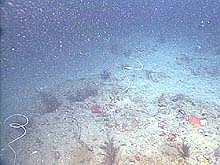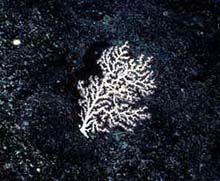
This spiral-shaped corkscrew coral (lower left and center), seen on the Savannah Scarp, is a type of antipatharian coral. Click image for larger view.
Deep-water Corals: How Far Do They Range?
Dr. Scott C. France
Department of Biology
College of Charleston
Charleston, SC
While we know relatively little about the species that inhabit the deep sea, we know even less about the geographic area over which these populations of species are spread. Compared to shallow-water and terrestrial habitats, environmental conditions (e.g., temperature and salinty) in the deep sea are relatively homogeneous from pole to pole. Could species survive anywhere throughout the global deep sea? If so, would these wide-ranging populations be able to maintain contact? Or, would the populations be so far apart that they could not exchange individuals with each other? These questions are important because they bear on the ecology and evolution of these species, including deep-water corals.
Deep-water corals include octocorals, antipatharians, and scleractinian or "stony" corals. Octocorals, also known as alcyonarians, are so named because each polyp in the colony has eight tentacles. They include the familiar sea fans, sea whips, and soft corals that are common on Caribbean reefs. Antipatharians have a flexible internal skeleton that is black with thorn-like bumps on it; hence, the common names "black" or "horny" coral. Antipatharian skeletons are used to make black coral jewelry, whereas precious pink coral jewelry comes from certain species of octocorals. The scleractinians form the familiar coral reefs of shallow-water tropical seas. Most deep-sea scleractinians do not form large reefs (Lophelia is an exception), but rather are solitary, or form small colonies.
Home is Where the Larvae Roam
Corals live a sessile existence, attached to the sea floor. In order to disperse from one area to another, these animals depend on free-swimming larvae. One question we are interested in is "How far are the larvae able to travel?" The answer to this question may have a bearing on the conservation of these species. For example, if a local population of corals is driven extinct, as is possible due to damage done by fishing trawlers, from how far can new recruits come to replenish the depleted habitat?
By studying the dispersal capabilities of the octocoral larvae, we can also study the evolution of octocoral species. If populations are isolated from one another, they will evolve independently, and, given sufficient time, could diverge into different species. Thus, barriers to dispersal between populations may be a mechanism for speciation in the deep sea. Knowledge of dispersal potential can help address these questions.

The deep-sea octocoral Corallium ducale.
This photo was taken on Cross Seamount (south of Hawaii) at 1,370 m depth. Click image for larger view.
DNA: A Genetic 'Travelogue'
It is impractical to tag and track deep-sea animals to follow their movements, particularly benthic invertebrates, which disperse as larvae. We may be able to get a sense of historical movements, however, by examining genetic patterns of populations. Isolated populations will accumulate genetic mutations that are different from those found in other populations. These mutations need not be detrimental to the organism, and can be used as a sort of marker of genetic identity. On this cruise (as well as on the Deep East cruise to the Georges Bank canyons and seamounts) we are collecting fragments of coral colonies so that we may study these genetic patterns. Only small amounts of tissue are required -- when ever possible, the sub clips off only a single branch, leaving the colony in place.
Once back in the lab, we can extract the DNA and sequence specific genes. By comparing the DNA sequences of octocorals from different populations, we can look for similarities and differences, which may, in turn, help us understand how far the octocoral larvae can disperse. These gene sequences can also be used to identify species, as kind of a genetic "bar code."
Sign up for the Ocean Explorer E-mail Update List.











































